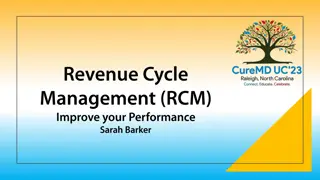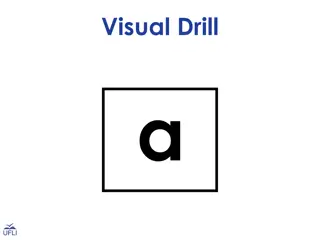
Weighted Graphs: Dijkstra vs. Bellman-Ford Algorithms
Explore the concepts of weighted graphs, specifically focusing on the Dijkstra and Bellman-Ford algorithms. Get insights into shortest path calculations, exam instructions, and lecture highlights in this informative session.
Uploaded on | 1 Views
Download Presentation

Please find below an Image/Link to download the presentation.
The content on the website is provided AS IS for your information and personal use only. It may not be sold, licensed, or shared on other websites without obtaining consent from the author. If you encounter any issues during the download, it is possible that the publisher has removed the file from their server.
You are allowed to download the files provided on this website for personal or commercial use, subject to the condition that they are used lawfully. All files are the property of their respective owners.
The content on the website is provided AS IS for your information and personal use only. It may not be sold, licensed, or shared on other websites without obtaining consent from the author.
E N D
Presentation Transcript
Lecture 11 Weighted Graphs: Dijkstra and Bellman-Ford NOTE: We may not get to Bellman-Ford! We will spend more time on it next time. 1
Announcements The midterm is today, 6-9pm. Good luck! Don t talk about it after you are done we will tell you when it is ok to discuss the midterm. See Ed post for detailed midterm instructions and logistics. 2
Midterm instructions (condensed) Double check time and location One 2-sided cheat sheet allowed No scratch paper; extra blank sheets in exam DO NOT tear off any pages! Sign out with the TA before you leave 3
Previous two lectures Graphs! DFS Topological Sorting Strongly Connected Components BFS Shortest Paths in unweighted graphs 4
Today What if the graphs are weighted? Part 1: Dijkstra! This will take most of today s class Part 2: Bellman-Ford! Real quick at the end if we have time! We ll come back to Bellman-Ford in more detail, so today is just a taste. 5
Caltrain Hospital Stadium Gates YOU ARE HERE Packard CS161 Union Dish 6
Just the graph Caltrain Hospital Gates Stadium Packard CS161 Union Dish 7
Shortest path from Gates to the Union? Caltrain 17 10 Hospital 15 10 Gates 1 Stadium Packard 1 Run BFS 25 CS161 4 22 I should go to the dish and then back to the union! Union That doesn t make sense if I label the edges by walking time. 20 Dish 8
Shortest path from Gates to the Union? Caltrain 17 10 Hospital 15 weighted graph 10 Gates 1 Stadium Packard w(u,v) = weight of edge between u and v. 1 25 CS161 4 If I pay attention to the weights, I should go to Packard, then CS161, then the For now, edge weights are non- negative. 22 Union 20 union. 9 Dish
Shortest path problem What is the shortest path between u and v in a weighted graph? the cost of a path is the sum of the weights along that path The shortest path is the one with the minimum cost. This path from s to t has cost 25. 20 3 2 s t 1 1 2 1 This path is shorter, it has cost 5. The distance d(u,v) between two vertices u and v is the cost of the the shortest path between u and v. For this lecture all graphs are directed, but to save on notation I m just going to draw undirected edges. = 10
Shortest paths Caltrain 17 10 Hospital 15 10 This is the shortest path from Gates to the Union. Gates Stadium 1 Packard CS161 1 It has cost 6. 4 25 22 Union Q: What s the shortest path from Packard to the Union? 20 Dish 11
Warm-up A sub-path of a shortest path is also a shortest path. Say this is a shortest path from s to t. Claim: this is a shortest path from s to x. Suppose not, this one is a shorter path from s to x. But then that gives an even shorter path from s to t! x t s 12
Single-source shortest-path problem I want to know the shortest path from one vertex (Gates) to all other vertices. Destination Cost To get there Packard 1 Packard CS161 2 Packard-CS161 Hospital 10 Hospital Caltrain 17 Caltrain Union 6 Packard-CS161-Union Stadium 10 Stadium Dish 23 Packard-Dish (Not necessarily stored as a table how this information is represented will depend on the application) 13
Example what is the shortest path from Palo Alto to [anywhere else] using BART, Caltrain, lightrail, MUNI, bus, Amtrak, bike, walking, uber/lyft. Edge weights have something to do with time, money, hassle. 14
Example Network routing I send information over the internet, from my computer to to all over the world. Each path has a cost which depends on link length, traffic, other costs, etc.. How should we send packets? 15
Caltrain Hospital Stadium Gates Packard Back to this example CS161 Union Dish 17
Gates Dijkstra s algorithm 1 CS161 Finds shortest paths from Gates to everywhere else. 1 Packard 4 22 Union 25 20 Dish 18
Dijkstra intuition YOINK! Gates CS161 Packard Dish Union 19
Dijkstra intuition A vertex is done when it s not on the ground anymore. YOINK! Gates CS161 Packard Dish Union 20
Dijkstra intuition YOINK! Gates 1 Packard CS161 Dish Union 21
Dijkstra intuition YOINK! Gates 1 Packard 1 CS161 Dish Union 22
YOINK! Dijkstra intuition Gates 1 Packard 1 CS161 4 Union Dish 23
YOINK! Dijkstra intuition Gates 1 Packard 1 CS161 4 22 Union Dish 24
YOINK! Dijkstra intuition Gates 1 Packard This creates a tree! 1 CS161 The shortest paths are the lengths along this tree. 4 22 Union Dish 25
How do we actually implement this? Without string and gravity? 26
Dijkstra by example 0 Gates How far is a node from Gates? 1 CS161 I m not sure yet I m sure 1 x = d[v] is my best over-estimate for dist(Gates,v). x Packard 4 Initialize d[v] = for all non-starting vertices v, and d[Gates] = 0 22 Pick the not-surenode u with the smallest estimate d[u]. Union 25 20 Dish 27
Dijkstra by example 0 Gates How far is a node from Gates? 1 CS161 I m not sure yet I m sure 1 x = d[v] is my best over-estimate for dist(Gates,v). x Packard 4 Current node u 22 Pick the not-surenode u with the smallest estimate d[u]. Update all u s neighbors v: d[v] = min( d[v] , d[u] + edgeWeight(u,v)) Union 25 20 Dish 28
Dijkstra by example 0 Gates How far is a node from Gates? 1 CS161 I m not sure yet I m sure 1 x = d[v] is my best over-estimate for dist(Gates,v). x Packard 1 4 Current node u 22 Pick the not-surenode u with the smallest estimate d[u]. Update all u s neighbors v: d[v] = min( d[v] , d[u] + edgeWeight(u,v)) Mark u assure. Union 25 20 Dish 25 29
Dijkstra by example 0 Gates How far is a node from Gates? 1 CS161 I m not sure yet I m sure 1 x = d[v] is my best over-estimate for dist(Gates,v). x Packard 1 4 Current node u 22 Pick the not-surenode u with the smallest estimate d[u]. Update all u s neighbors v: d[v] = min( d[v] , d[u] + edgeWeight(u,v)) Mark u assure. Repeat Union 25 20 Dish 25 30
Dijkstra by example 0 Gates Packard has three neighbors. What happens when we update them? 1 min. think; 1 min. share How far is a node from Gates? 1 CS161 I m not sure yet I m sure 1 x = d[v] is my best over-estimate for dist(Gates,v). x Packard 1 4 Current node u 22 Pick the not-surenode u with the smallest estimate d[u]. Update all u s neighbors v: d[v] = min( d[v] , d[u] + edgeWeight(u,v)) Mark u assure. Repeat Union 25 20 Dish 25 31
Dijkstra by example 0 Gates Packard has three neighbors. What happens when we update them? How far is a node from Gates? 2 1 CS161 I m not sure yet I m sure 1 x = d[v] is my best over-estimate for dist(Gates,v). x Packard 1 4 Current node u 22 Pick the not-surenode u with the smallest estimate d[u]. Update all u s neighbors v: d[v] = min( d[v] , d[u] + edgeWeight(u,v)) Mark u assure. Repeat Union 25 20 Dish 23 32
Dijkstra by example 0 Gates How far is a node from Gates? 2 1 CS161 I m not sure yet I m sure 1 x = d[v] is my best over-estimate for dist(Gates,v). x Packard 1 4 Current node u 22 Pick the not-surenode u with the smallest estimate d[u]. Update all u s neighbors v: d[v] = min( d[v] , d[u] + edgeWeight(u,v)) Mark u assure. Repeat Union 25 20 Dish 23 33
Dijkstra by example 0 Gates How far is a node from Gates? 2 1 CS161 I m not sure yet I m sure 1 x = d[v] is my best over-estimate for dist(Gates,v). x Packard 1 4 Current node u 22 Pick the not-surenode u with the smallest estimate d[u]. Update all u s neighbors v: d[v] = min( d[v] , d[u] + edgeWeight(u,v)) Mark u assure. Repeat Union 25 20 Dish 23 34
Dijkstra by example 0 Gates How far is a node from Gates? 2 1 CS161 I m not sure yet I m sure 1 x = d[v] is my best over-estimate for dist(Gates,v). x Packard 1 4 Current node u 6 22 Pick the not-surenode u with the smallest estimate d[u]. Update all u s neighbors v: d[v] = min( d[v] , d[u] + edgeWeight(u,v)) Mark u assure. Repeat Union 25 20 Dish 23 35
Dijkstra by example 0 Gates How far is a node from Gates? 2 1 CS161 I m not sure yet I m sure 1 x = d[v] is my best over-estimate for dist(Gates,v). x Packard 1 4 Current node u 6 22 Pick the not-surenode u with the smallest estimate d[u]. Update all u s neighbors v: d[v] = min( d[v] , d[u] + edgeWeight(u,v)) Mark u assure. Repeat Union 25 20 Dish 23 36
Dijkstra by example 0 Gates How far is a node from Gates? 2 1 CS161 I m not sure yet I m sure 1 x = d[v] is my best over-estimate for dist(Gates,v). x Packard 1 4 Current node u 6 22 Pick the not-surenode u with the smallest estimate d[u]. Update all u s neighbors v: d[v] = min( d[v] , d[u] + edgeWeight(u,v)) Mark u assure. Repeat Union 25 20 Dish 23 37
Dijkstra by example 0 Gates How far is a node from Gates? 2 1 CS161 I m not sure yet I m sure 1 x = d[v] is my best over-estimate for dist(Gates,v). x Packard 1 4 Current node u 6 22 Pick the not-surenode u with the smallest estimate d[u]. Update all u s neighbors v: d[v] = min( d[v] , d[u] + edgeWeight(u,v)) Mark u assure. Repeat Union 25 20 Dish 23 38
Dijkstra by example 0 Gates How far is a node from Gates? 2 1 CS161 I m not sure yet I m sure 1 x = d[v] is my best over-estimate for dist(Gates,v). x Packard 1 4 Current node u 6 22 Pick the not-surenode u with the smallest estimate d[u]. Update all u s neighbors v: d[v] = min( d[v] , d[u] + edgeWeight(u,v)) Mark u assure. Repeat Union 25 20 Dish 23 39
Dijkstra by example 0 Gates How far is a node from Gates? 2 1 CS161 I m not sure yet I m sure 1 x = d[v] is my best over-estimate for dist(Gates,v). x Packard 1 4 Current node u 6 22 Pick the not-surenode u with the smallest estimate d[u]. Update all u s neighbors v: d[v] = min( d[v] , d[u] + edgeWeight(u,v)) Mark u assure. Repeat Union 25 20 Dish 23 40
Dijkstra by example 0 Gates How far is a node from Gates? 2 1 CS161 I m not sure yet I m sure 1 x = d[v] is my best over-estimate for dist(Gates,v). x Packard 1 4 Current node u 6 22 Pick the not-surenode u with the smallest estimate d[u]. Update all u s neighbors v: d[v] = min( d[v] , d[u] + edgeWeight(u,v)) Mark u assure. Repeat After all nodes are sure, say that d(Gates, v) = d[v] for all v Union 25 20 Dish 23 41
Dijkstras algorithm Dijkstra(G,s): Set all vertices to not-sure d[v] = for all v in V d[s] = 0 While there are not-sure nodes: Pick the not-sure node u with the smallest estimate d[u]. For v in u.neighbors: d[v] min( d[v] , d[u] + edgeWeight(u,v)) Mark u as sure. Now d(s, v) = d[v] Lots of implementation details left un-explained. We ll get to that! See IPython Notebook for code! 42
As usual Does it work? Yes. Is it fast? Depends on how you implement it. 43
Why does this work? Theorem: Suppose we run Dijkstra on G =(V,E), starting from s. At the end of the algorithm, the estimate d[v] is the actual distance d(s,v). Let s rename Gates to s , our starting vertex. Proof outline: Claim 1: For all v, d[v] d(s,v). Claim 2: When a vertex v is marked sure, d[v] = d(s,v). Claim 2 Claims 1 and 2 imply the theorem. When v is marked sure, d[v] = d(s,v). d[v] d(s,v) and never increases, so after v is sure, d[v] stops changing. This implies that at any time after v is marked sure, d[v] = d(s,v). All vertices are sure at the end, so all vertices end up with d[v] = d(s,v). Claim 1 + def of algorithm 44 Next let s prove the claims!
Intuition! Claim 1 d[v] d(s,v) for all v. Informally: 0 Gates 2 Every time we update d[v], we have a path in mind: CS161 1 d[v] min( d[v] , d[u] + edgeWeight(u,v) ) Packard1 1 Whatever path we had in mind before The shortest path to u, and then the edge from u to v. 25 4 d[v] = length of the path we have in mind length of shortest path = d(s,v) 6 Union 22 20 Formally: We should prove this by induction. (See skipped slide or do it yourself) Dish 23 45
YOINK! Intuition for Claim 2 When a vertex u is marked sure, d[u] = d(s,u) s Gates The first path that lifts u off the ground is the shortest one. 1 Packard 1 Let s prove it! Or at least see a proof outline. CS161 4 u Union Dish 47
Informal outline! Claim 2 When a vertex u is marked sure, d[u] = d(s,u) Inductive Hypothesis: When we mark the t th vertex v as sure, d[v] = dist(s,v). Base case (t=1): The first vertex marked sure is s, and d[s] = d(s,s) = 0. Inductive step: Assume by induction that every v already marked sure has d[v] = d(s,v). Suppose that we are about to add u to the sure list. That is, we picked u in the first line here: (Assuming edge weights are non-negative!) Pick the not-sure node u with the smallest estimate d[u]. Update all u s neighbors v: d[v] min( d[v] , d[u] + edgeWeight(u,v)) Mark u as sure. Repeat Want to show that d[u] = d(s,u). 48
Temporary definition: v is good means that d[v] = d(s,v) Claim 2 Inductive step Want to show that u is good. Consider a true shortest path from s to u: s u The vertices in between are beige because they may or may not be sure. True shortest path. 49
Temporary definition: v is good means that d[v] = d(s,v) Claim 2 Inductive step means good means not good by way of contradiction BWOC, suppose u isn t good. Want to show that u is good. Say z is the last good vertex before u (on shortest path to u). z is the vertex after z. z s z It may be that z = s. u u It may be that z = u. z != u, since u is not good. The vertices in between are beige because they may or may not be sure. True shortest path. 50
Temporary definition: v is good means that d[v] = d(s,v) Claim 2 Inductive step means good means not good Want to show that u is good. BWOC, suppose u isn t good. ? ? = ? ?,? ? ?,? ?[?] Subpaths of shortest paths are shortest paths. (We re also using that the edge weights are non-negative here). z is good r z s z u 51
Temporary definition: v is good means that d[v] = d(s,v) Claim 2 Inductive step means good means not good Want to show that u is good. BWOC, suppose u isn t good. ? ? = ? ?,? ? ?,? ?[?] Subpaths of shortest paths are shortest paths. z is good Claim 1 Since u is not good, ? ? ? ? . So ? ? < ? ? , so z is sure.We chose u so that d[u] was smallest of the unsure vertices. r z s z u 52






















